Cartoons by Mark Anderson


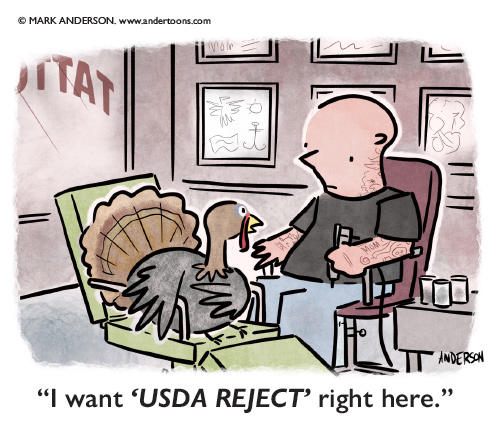
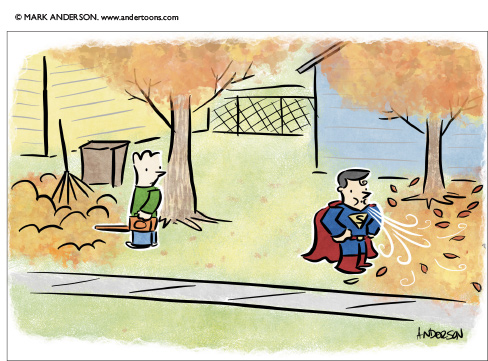

A Warm Round of Applause for ‘Exothermic Oxidation
Sam Venable
Department of Irony
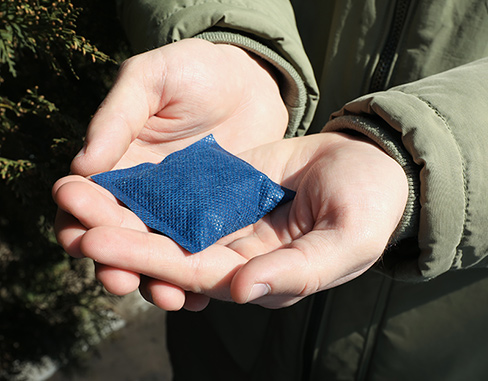 I have no idea how “exothermic oxidation” works. I wouldn’t know what to say — other than “ouch, %$&*!-it” and then drop like a load of bricks — if “exothermic oxidation” ran up and whacked me over the head with a tire tool.
I have no idea how “exothermic oxidation” works. I wouldn’t know what to say — other than “ouch, %$&*!-it” and then drop like a load of bricks — if “exothermic oxidation” ran up and whacked me over the head with a tire tool.
I couldn’t pick “exothermic oxidation” out of a police lineup.
But, boy-howdy, am I glad “exothermic oxidation” exists. It sure does keep my hands and fingers toasty.
“Exothermic oxidation” is what occurs when iron powder is mixed with water, salt, activated charcoal and vermiculite and then exposed air. The result is heat — without flames, fumes or smoke. Happily, you don’t have to stock up on all those ingredients. Or mix them. Someone will do it for you, and even wrap everything in a tidy, flat little package. All you gotta do is supply the air.
If you haven’t guessed by now, I’m talking about cheap, disposable hand warmers that sell by the mega-bazillion this time of year. They’re available at supermarkets, hardware stores, outdoor shops, convenience stores and anywhere else commerce is conducted. Usually they come in packs of three, although I’ve seen, and purchased, many of them in batches of 10. You can never buy too many.
Nor can you buy ’em too large. None of those itty-bitty, palm-sized models for me, thank you just the same. I prefer the “body super warmers” which are advertised to stay hot for 18 hours.
OK, so technically, “body” is misleading unless we’re talking chihuahuas; they’re only about 2½ times larger than the regular ones. And 18 hours stretches the truth like a cheap rubber band; eight to 10 hours max has been my experience. Nonetheless, one in each coat pocket will turn misery into comfort all day long.
When I was a kid, “cigarette lighter” hand warmers were all the rage. You know, those flat, shiny metal cases tucked inside a red velvet pouch. The hateful things were a pain to keep stoked with fluid. They were difficult to ignite in the wind. They stunk like the dickens. And if a lit one ever slipped out of the pouch and touched bare skin, it felt like you’d just been brushed by a glowing horseshoe fresh from the forge.
Not so these days. I don’t care how many pairs of gloves and mittens you own or how much high-tech, waterproof fiber they contain; when it’s big-time cold, gloves and mittens won’t do a complete job unless used in tandem with good ol’ “exothermic oxidation.”
Don’t take my word for it. Ask anybody who ventures outdoors from first frost to spring thaw, for work or for play. If I’m hunting or fishing during cold weather, I’d rather leave guns or tackle at home than hand warmers. How in the name of Daniel Boone did we ever exist without them?
Of course, “big-time cold” here in the South means anything from 38 degrees above zero Fahrenheit down to minus-100 degrees Celsius — and let us pause for a moment so ice-fishing and snow-snowmobiling Yankee readers can laugh their frozen heads off and call us wimps. We’ll return the favor when those same Yankee readers melt and moan about “big-time hot” when both the temperature and humidity are pushing 90. So there.
Sam Venable is an author, comedic entertainer, and humor columnist for the Knoxville (TN) News Sentinel. His latest book is “The Joke’s on YOU! (All I Did Was Clean Out My Files).” He may be reached at sam.venable@outlook.com.
Nibi the Beaver Gets Official Reprieve
The question of whether a 2-year-old beaver named Nibi can stay with the rescuers she has known since she was a baby or must be released into the wild was resolved Thursday when the Massachusetts governor stepped in to protect Nibi.

The state issued a permit to Newhouse Wildlife Rescue for Nibi to remain at the rehabilitation facility and serve as an educational animal.
“Nibi has captured the hearts of many of our residents, mine included,” Massachusetts Governor Maura Healey said Thursday. “We’re excited to share that we have issued a permit for Nibi to remain in Newhouse’s care, continuing to educate the public about this important species.”
Nibi’s fate had made it all the way to the state courts before Healey stepped in.
A judge on Tuesday had said that Nibi would be allowed to stay in her home at the rescue center in Chelmsford, located northwest of Boston. A hearing had been set for Friday in a case filed by the rescuers against MassWildlife, the state’s division of fisheries and wildlife, to stop the release.
Nibi’s rescuers at Newhouse Wildlife Rescue said on their Facebook page that they were “beyond grateful” for Healey’s decision.
Nibi has been a hit on the rescue goup’s social media since she was a baby, and posts about her impending release garnered thousands of comments.
An online petition to save Nibi from being released into the wild has received over 25,000 signatures, lawmakers have weighed in, and earlier this week Healey pledged to make sure Nibi is protected.
“We all care about what is best for the beaver known as Nibi and all wild animals throughout our state,” Mark Tisa, director of MassWildlife, said in a statement Thursday. “We share the public’s passion for wildlife and invite everyone to learn more about beavers and their important place in our environment.”
Jane Newhouse, the rescue group’s founder and president, has said that after Nibi was found on the side of the road, they tried to reunite her with nearby beavers who could have been her parents but were unsuccessful. After that, attempts to get her to bond with other beavers also didn’t work.
“It’s very difficult to consider releasing her when she only seems to like people and seems to have no interest in being wild or bonding with any of her own species,” she said.
Nibi has a large enclosure with a pool at the rescue operation, and will also wander in its yard and rehabilitation space, Newhouse said. “She pretty much has full run of the place. Everybody on my team is in love with her,” she said.
Newhouse said she had asked MassWildlife if she could get a permit for Nibi to become an educational beaver, allowing her to take the beaver to schools, libraries and town halls. Newhouse said she feared a release would mean certain death for her beloved “diva” beaver, who doesn’t know how to live in the wild.
“It doesn’t give her much time... to figure out how to build a lodge for the first time, how to build dams for the first time, how to store all of her food before winter sets in,” she said.
Newhouse said that beavers usually leave their parents between the ages of 2 and 3, so it’s possible that over the next year Nibi will show more interest in wanting to be in the wild. But unless that happens, she wants to keep her safe.
Beavers are common and abundant throughout Massachusetts. A keystone species, beavers play an important role in fostering biodiversity of ecosystems, according to state officials.
By damming rivers and streams, and forming shallow ponds, beavers are vital for creating healthy wetlands that support a tremendous diversity of plants, bugs, and wildlife, and store floodwaters during storms.
They are also North America’s largest native rodents, weighing between 35 and 80 pounds (16 and 36 kilograms) and reaching 2–3 feet (0.6-0.9 meters) in length as adults.
Adult beavers have very few predators and can live for 20 years or more.
In almost all cases, it’s best to leave wildlife alone, officials said, so they don’t come to rely on humans for food and shelter.
Pumpkin Weighing 2,471 Pounds Wins Annual California Contest
HALF MOON BAY, CA — A Minnesota horticulture teacher remained the reigning champion Monday of an annual pumpkin-weighing contest in Northern California where his massive gourds have won the top prize four years in a row.
Travis Gienger, of Anoka, Minnesota, beat his closest competitor by 6 pounds to clinch the victory at the 51st World Championship Pumpkin Weigh-Off in Half Moon Bay, south of San Francisco.
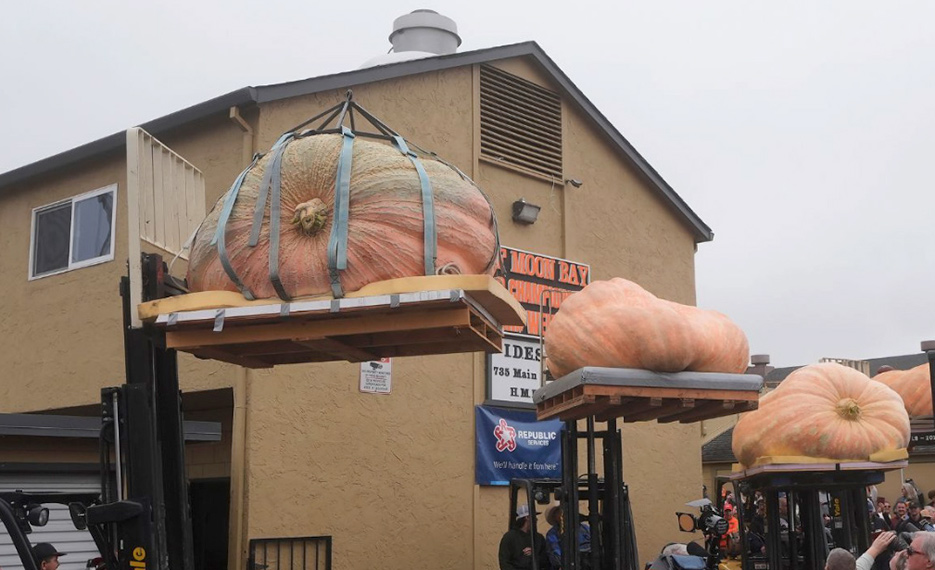 |
|
Travis Gienger’s prize-winning pumpkin weighs over 2 tons. |
His winning gourd came in at 2,471 pounds, falling short of the world record he set last year with a pumpkin weighing 2,749 pounds (1,247 kilograms).
Gienger, 44, said that as he has done in the past, he focused on having healthy soil and well-fed plants but that a cold fall with record-breaking rain likely impacted his pumpkin’s growth.
“We had really, really tough weather and somehow, some way, I kept on working,” Gienger said. “I had to work for this one, and we got it done at the end, but it wasn’t by much.”
Gienger and his family drove his gargantuan gourd for 35 hours to California.
He said the giant pumpkin’s next stop will be in Southern California, where a team of professional carvers will do a 3D carve on it at a Halloween event.
North American Wife-Carrying Championship Attracts Competitive Couples to Maine
An annual event involving dirt, beer and cash once again drew dozens of eager competitors to a ski resort in Maine one Saturday in October.
More than 30 couples competed in the North American Wife Carrying Championship, a 278-yard (254-meter) race during which contestants splash through water, leap over logs and trudge through mud — all while carrying their partner like a sack of potatoes.
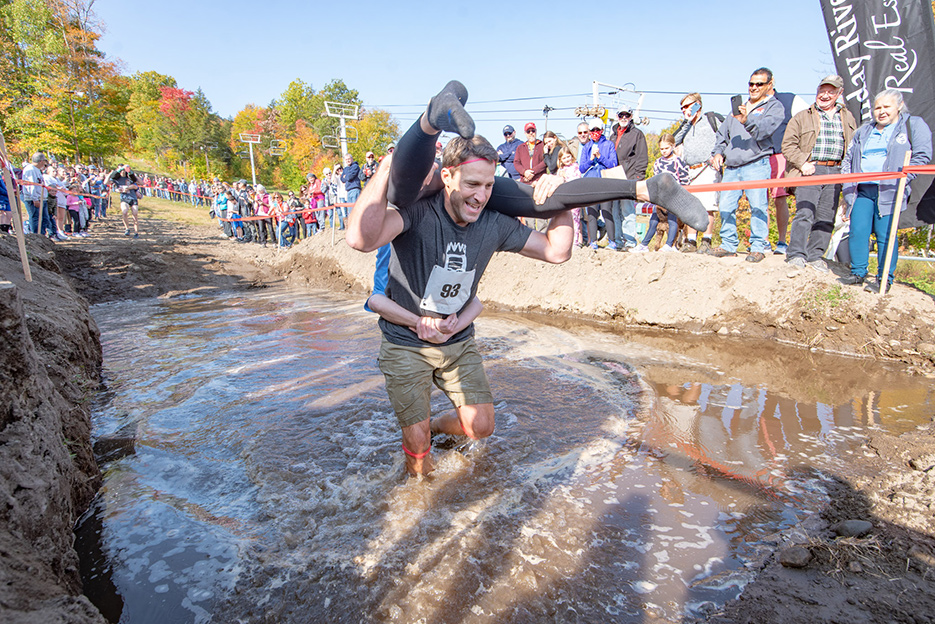
The sport’s origin story isn’t exactly politically correct. It’s based on a 19th century Finnish legend involving a man known as “Ronkainen the Robber,” whose gang was known to pillage villages and carry away the women, according to one of the explanations included on the website wife-carrying.org.
Traditionally, the Finnish event featured male competitors carrying a woman. On Saturday, competing couples didn’t have to be married, nor did they have to be a man and a woman.
One contestant — the carrier — was dressed as Mr. Incredible, while his “wife” was dressed entirely in pink. They and others were cheered on heartily by crowds on both sides of the course at Sunday River ski resort. Most managed to navigate the grassy hillside, but a few stumbled in the mud, their female partners jumping off before they regrouped and kept going.
Most of the participants use a technique in which the “wife” is carried like a backpack — upside down — to ensure the runners’ arms are free for the greatest agility. Wearing smiles and grimaces, competitors end up wet and muddy.
The champion leaves with the weight of the “wife” in beer and five times the “wife’s” weight in cash. To estimate the amount they win, the winning “wife” is put on one side of a see-saw-like scale that organizers balance out on the other side with cases of beer.
“We come each year for the fun,” said Wade Porterfield of Cuba, New York, who competed with his wife, Sara Porterfield. “There is really a low chance of us winning. Pretty much everybody cheers everybody on and it’s a blast.”
Wife Carrying originated in Finland, and its history is based around the 19th century legend of Herkko Rosvo-Ronkainen, or “Ronkainen the Robber.” There are three stories as to how the sport was created. First, Ronkainen and his thieves were accused of stealing food and women from villages in the area he lived in; then carried these women on their backs as they ran away. Second, it has been said the men would go to villages near their own to steal other men’s wives, and then have the woman become their own wife. Third is the story that Ronkainen trained his thieves by carrying big, heavy sacks on their backs, which could have eventually evolved to a sport.
The first modern day wife carrying event was held in Finland in 1992 and foreign contestants were admitted in 1995. This event is now held annually in Sonkajärvi, Finland as the World Championship. The North American Championship was started in 1999.